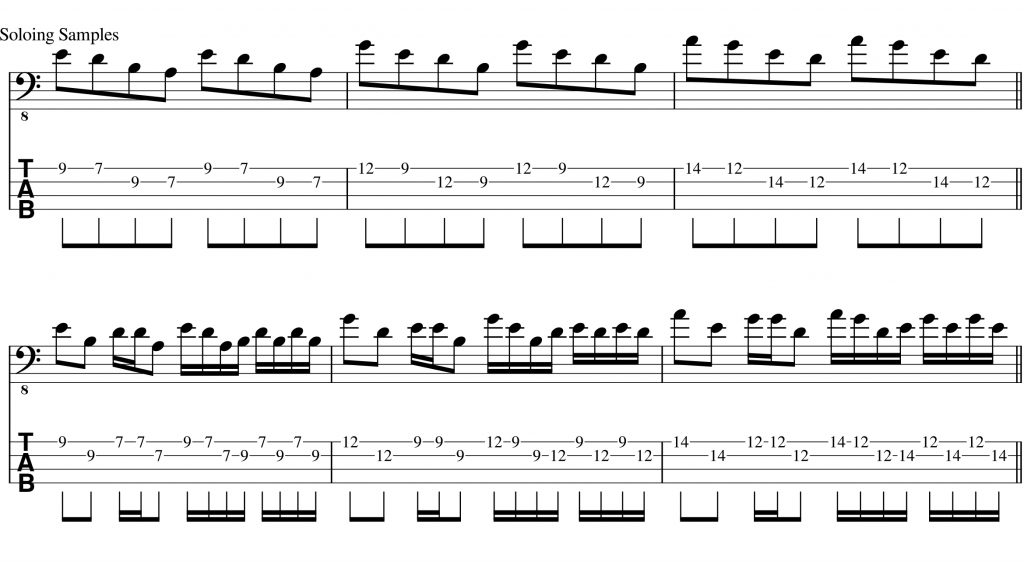Ah, boxes…and it’s not even Christmas yet!
Box shapes are easy: two notes per string and two fingers plucking in the right hand. It’s super comfortable and lends itself to doing hip riffing and cool filling even at higher tempos.
The trick about pentatonics is knowing which scale to use and when. I lay it all out in my Pentatonic Playground for Bass course: the five shapes to know and what to do with them. I give the shapes descriptive names because that makes them stick better. But whether you are hip to “The Boot”, “Little Box/Big Box” and the others, here is a super easy trick for some pentatonic coolness. Think inside the box!
Let’s take just the top two strings of your bass and play the pattern below by “boxes”. The two purple ones you’d finger with the first and third fingers, and the brown one with one and four.
Like this:

TAB and score:

Now that you have them under your fingers, the fun can begin! First, let’s figure out the chords over which we can play this. Then I will show you how to use these boxes as a spring board for a variety of ideas.
The Chords
There are quite a few possibilities of chords where these boxes will fit. In fact, every single one of these notes could be the root of a possible chord. And because part of the coolness of pentatonics is that there are no bad sounding notes, you can box away to your heart’s content.
E min, G major
The notes of these boxes are the E minor pentatonic, which shares its notes with the G major pentatonic, so both of these chords work. The resulting sound is very “inside” and stable, pretty much the notes you’d expect. Can’t go wrong here! E7 would also work, resulting in a bluesy effect.
We can, however, also impose this E minor/G major pentatonic over other chords. This creates a pleasant sounding mild polytonality effect.
A min7 or A sus
We got the root, the fifth, the seventh, the ninth and the 11th (or fourth). Beautiful over an A min or A sus chord!
B min7 or B sus7
For B minor we got the root, flat three, flat seventh and the flat sixth.
For B sus7 we are getting a bluesy feel (#9!) and the b13 as well. A bit tense, but works given the right context!
D sus9
Here we get the natural 13 and the 9 in addition to 1-4-5.
How about some chords not in the boxes?
C major would work great. The boxes give us the sixth and major second (or ninth), and the chord tones of a C major 7 chord without the root. Very sweet.
F major
The box notes create a beautiful lydian effect: maj7, 9, #11, 13 – gorgeous!
Now that’s a smorgasboard of chords for just a few notes, isn’t it? Notice that it’s all the chords of the G maj scale (or E natural minor) except for the 7th degree (half dimished), which is replaced by the flat seven in maj (F major).
The Riffin’
Come up with a riff in the first purple box (basically you play the box corners in any order or rhythm you like). Then, move the same pattern through the brown and second purple boxes. Voila, you have a cool strategy for coming up with riffs. Below are some examples for soloing licks. When you use them going up like this in your solo, make sure to resolve the tension created with a target note and clear resolution.

Keep in mind that as bassists most often our number one job is to play the root on beat one, so, unless you are soloing, keep these riffs for beats 3 and 4 in the bar. It sounds neat if you groove on the root (see slash notation, use any of the chords we identified above) and fill with this material over a few measures going up in your boxes. It sounds dramatic! Like this:

Now put on a groove of that one chord and go to town, grooving and soloing! Within songs and on the bandstand make sure to use devices like this with taste – they need to fit in with what the rest of the band is doing. Placed at just the right spot in the arrangement, this is sure to have big impact. You can also check out more on cool boxes with Pentatonic Playground for Bass!


